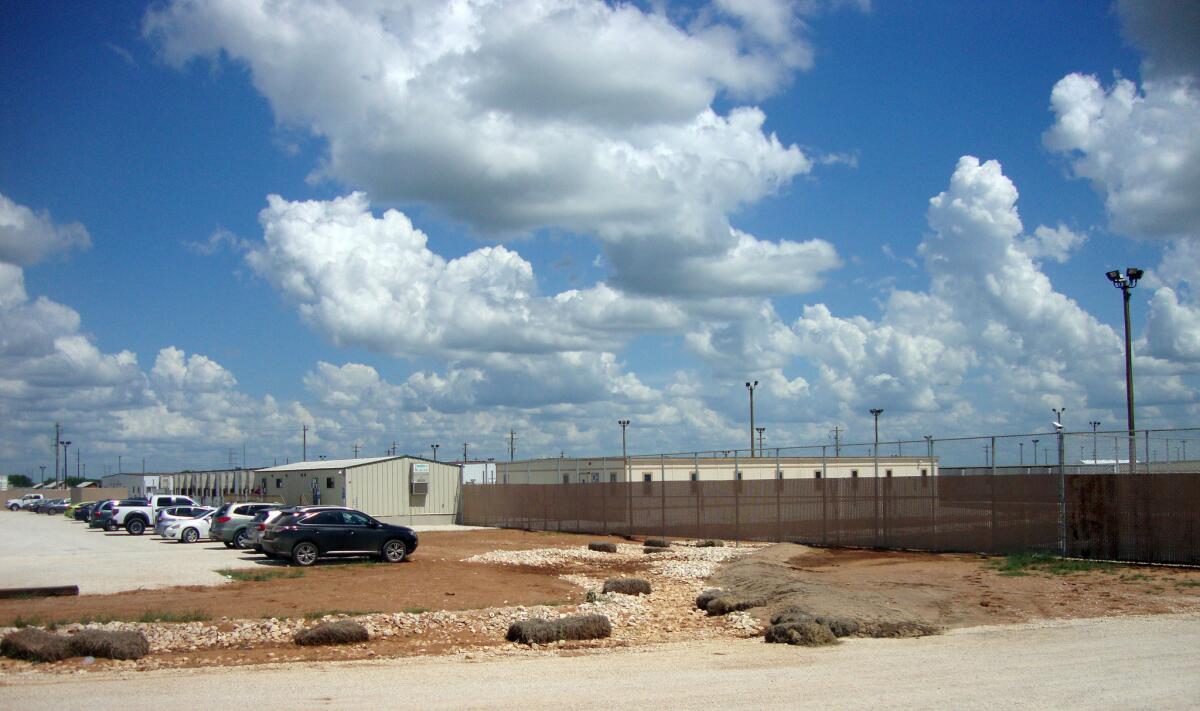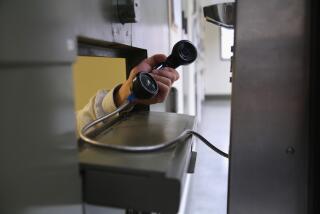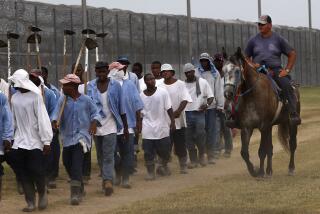Paid $1 to $3 a day, unauthorized immigrants keep family detention centers running

The South Texas Family Residential Center is the largest of the nation’s three immigration detention centers for families, housing up to 2,400 people.
Reporting from Houston — Delmi Cruz fled Honduras in September with her son Alexis, 11, illegally crossing the border into the U.S. and ending up at a family detention center in rural Texas.
“I worked immediately,” Cruz said. “In order to have something to eat, to buy treats for my son.”
Cruz, 36, cleaned bathrooms, hallways and other areas of the government-contracted detention center for $3 a day. At the commissary, a bag of potato chips cost $4, bottled water $2. The facility in Karnes City is run by Geo Group, the country’s second-largest prison company.
“It was voluntary,” Cruz said of her work there, but “it wasn’t fair.”
Cruz encapsulates the sentiments of critics who question how detainees are used to keep detention centers running. Immigrant advocates say detainees are underpaid and have been removed from their jobs as punishment. Lawsuits in Colorado and Massachusetts claim the work program isn’t voluntary at all.
Unauthorized immigrants at family and other detention centers are paid $1 to $3 a day through the detainee voluntary work program. They clean, cook, launder, landscape and perform other jobs.
“It’s ironic — it’s illegal for them to work, but they’re working for the immigration service in a sense,” said Mark Krikorian, executive director of the Center for Immigration Studies, a conservative think tank in Washington.
“It can be a useful element of managing people in detention,” Krikorian added. “I don’t have any problem with it in principle. The question is: Is it run well?”
Government contracts not only condone detainees working, they bank on it, experts said, exploiting a legal loophole that has prompted class-action lawsuits by immigrants and advocates.
“We have a name for locking people up and forcing them to do real work without wages. It’s called slavery,” said Carl Takei, a staff attorney with the ACLU National Prison Project who recently visited the family detention center in Dilley, Texas.
In 1950, Congress passed a law allowing the dollar-a-day pay rate for voluntary labor in immigrant detention. When lawmakers last reviewed the rate in 1979, Takei said, they chose not to raise it, and an appellate court upheld the rate in 1990, finding “alien detainees are not government ‘employees.’ ”
While inmates may be forced to work at the nation’s prisons, Takei said, there’s a legal difference between inmates and detainees. “The key distinction is ICE detention is not supposed to be punishment,” he said.
In addition to three facilities for families, there are more than 80 other facilities where ICE houses immigrants nationwide, including some run by local law enforcement. ICE is funded to house 34,000 immigrants daily. Of those, tens of thousands are working annually based on ICE contracts, according to Jacqueline Stevens, a political science professor and director of the Deportation Research Clinic at Northwestern University.
Federal officials say the work improves morale and discipline and reduces expenses in a detention system that costs about $2 billion annually.
“The program allows detainees to feel productive and contribute to the orderly operation of detention facilities,” said Gillian Christensen, an ICE spokeswoman.
Detainees cannot work more than 40 hours a week and eight hours a day and are limited to duties that directly contribute to the operation of the facility. There are usually more volunteers than jobs, she said.
Homeland Security Department contracts with those who run the centers include estimates of how much voluntary labor the detainees will provide, said Andrew Free, an immigration attorney from Nashville who has volunteered at the detention center in Dilley.
Denise Gilman, director of the immigration law clinic at the University of Texas at Austin, said the work program is “not a service to the women. It’s part of their profit-making model.”
Detainees are charged two to seven times more for most products in detention centers’ commissaries than they would pay at a local Wal-Mart, according to a study by Nancy Hiemstra, assistant professor of migration studies at Stony Brook University.
In class-action lawsuits filed during the last year in Colorado and Massachusetts, immigrants allege the work program is involuntary, in some cases unpaid, and violates state minimum wage laws.
Free and other attorneys for nine immigrants at a 1,500-bed facility in Aurora, Colo., sued Geo Group in October, alleging they were threatened with punishment for not participating in the work program, including solitary confinement. A judge found they could proceed with claims that the company unjustly enriched itself and violated a federal law barring the forced labor of human trafficking victims.
NEWSLETTER: Get the day’s top headlines from Times Editor Davan Maharaj >>
Pablo Paez, a Geo Group spokesman, said the company “strongly refutes” the allegations in the lawsuit, adding in a statement that the company’s detention centers “provide high-quality services in safe, secure and humane residential environments.”
“The volunteer work program at immigration facilities as well as the wage rates and standards associated with the program are set by the federal government,” Paez said.
He said the company’s ICE-contracted facilities are audited and inspected by the agency on a “routine and unannounced basis,” and accredited by the American Correctional Assn., receiving average scores above 99%.
But critics of the detainee work system argue it puts untrained immigrants at risk of injury and, in at least one instance, led to a death.
“There’s definitely occupational safety issues with this program,” said Stevens, the Northwestern professor.
She pointed to the case of Cesar Gonzalez, 36, of Pomona, who was working with a jackhammer while detained at the Mira Loma Detention Center in Lancaster in 2007. He struck a power line, was electrocuted, suffered burns and a heart attack and later died, according to Cal OSHA records.
Gonzalez’s wife sued Los Angeles County and the sheriff’s office, which contracted with ICE to run the detention center. She received a $750,000 settlement in 2012. Cal OSHA described the immigrant as an employee and faulted the detention center for what happened, fining it $18,750.
“As long as they find people doing that work are covered by Cal OSHA, how is it the position of these private companies and ICE that everybody else doing similar work isn’t covered?” Stevens said.
Critics also accuse the for-profit prison companies that run the detention centers of using work as leverage to control detainees.
In April, Cruz and two other detainees filed a federal lawsuit in San Antonio against Geo Group and Homeland Security, alleging they lost their jobs because they staged hunger strikes and work stoppages to demand improved conditions at the Karnes City center.
“As soon as we had the first hunger strike, they took away my work,” said Cruz, who was released in June and now lives with her son in Los Angeles. “They told me it was because I was the leader.”
Taking away immigrants’ jobs at detention centers “is a frequent form of punishment and is pretty potent,” said Free, the Nashville lawyer.
He and other critics also say that if detainees were better paid, the system would collapse.
“Immigration detention is only profitable if the labor is done by people who are not being paid minimum wage,” Free said. “You can’t run them unless you have this labor.”
Twitter: @mollyhf
Hoy: Léa esta historia en español
MORE IMMIGRATION COVERAGE:
Immigrants object to growing use of ankle monitors after detention
Judge blasts ICE, says immigrant children, parents in detention centers should be released
At a Texas church, volunteers offer more than sanctuary for new immigrants
More to Read
Sign up for Essential California
The most important California stories and recommendations in your inbox every morning.
You may occasionally receive promotional content from the Los Angeles Times.











